

Anuket. In Egyptian mythology, Anuket (also spelt Anqet, and in Greek, Anukis) was originally the personification and goddess of the Nile river, in areas such as Elephantine, at the start of the Nile's journey through Egypt, and in nearby regions of Nubia.

Anuket was part of a triad with the god Khnum, and the goddess Satis. She is the sister of the goddess Satis, or she may have been a junior consort to Khnum instead. [1] Anuket was depicted as a woman with a headdress of feathers [1] (thought by most Egyptologists to be a detail deriving from Nubia). [citation needed] Her sacred animal was the gazelle. A temple dedicated to Anuket was erected on the Island of Seheil. Inscriptions show that a shrine or altar was dedicated to her at this site by the 13th dynasty Pharaoh Sobekhotep III. Khnum. Khnum (/kəˈnuːm/; also spelled Khnemu) was one of the earliest Egyptian deities, originally the god of the source of the Nile River.
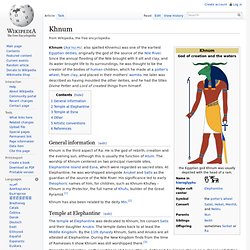
Since the annual flooding of the Nile brought with it silt and clay, and its water brought life to its surroundings, he was thought to be the creator of the bodies of human children, which he made at a potter's wheel, from clay, and placed in their mothers' wombs. He later was described as having moulded the other deities, and he had the titles Divine Potter and Lord of created things from himself. General information[edit] Temple at Elephantine[edit] The temple at Elephantine was dedicated to Khnum, his consort Satis and their daughter Anukis. Mami Wata. Contemporary poster of a Mami Wata, "serpent priestess" painted by German (Hamburg) artist Schleisinger, ca. 1926, displayed in shrines as a popular image of Mami Wata in Africa and in the Diaspora.[1][2]
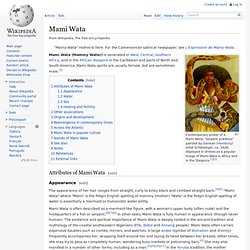
Nephthys. Etymology[edit] Nephthys - Musée du Louvre, Paris, France Nephthys is the Greek form of an epithet (transliterated as Nebet-het, and Nebt-het, from Egyptian hieroglyphs).The origin of the goddess Nephthys is unclear but the literal translation of her name is usually given as "Lady of the House," which has caused some to mistakenly identify her with the notion of a "housewife," or as the primary lady who ruled a domestic household.
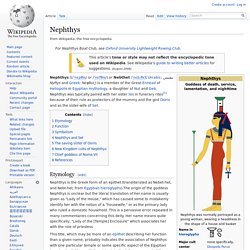
This is a pervasive error repeated in many commentaries concerning this deity. Her name means quite specifically, "Lady of the [Temple] Enclosure" which associates her with the role of priestess. Function[edit] Nephthys was known in some ancient Egyptian temple theologies and cosmologies as the "Useful Goddess" or the "Excellent Goddess".[2] These late Ancient Egyptian temple texts describe a goddess who represented divine assistance and protective guardianship. Triad of Isis, Nephthys, and Harpocrates.
Pyramid Text Utterance 222 line 210.[11] Nyami Nyami. The Nyami Nyami, otherwise known as the Zambezi River God or Zambezi Snake spirit, is one of the most important gods of the Tonga people.
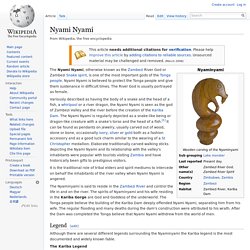
Nyami Nyami is believed to protect the Tonga people and give them sustenance in difficult times. The River God is usually portrayed as female. Oshun. Ọṣhun is beneficent, generous and very kind.

She does, however, have a horrific temper, one which she seldom ever loses. When she does, it causes untold destruction. Oshun is said to have gone to a drum festival one day and to have fallen in love with the king-dancer Shango, god of lightning & thunder. Since that day, Shango has been married to Oba, Oya, and Oshun, though Oshun is said to be considered his principal wife. Santería[edit] In Cuban Santería, Oshun (sometimes spelled Ochún or Ochun) is an Orisha of love, maternity and marriage. Olokun. Olokun is an Orisha in Yoruba religion, associated with the sea.[1] It works closely with Oya (Deity of the Winds) and Egungun (Collective Ancestral Spirits) to herald the way for those that pass to ancestorship, as it plays a critical role in Iku, Aye and the transition of human beings and spirits between these two existences.
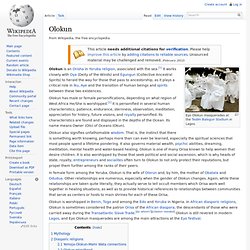
Sobek. Sobek (also called Sebek, Sochet, Sobk, and Sobki), and in Greek, Suchos (Σοῦχος) was an ancient Egyptian deity with a complex and fluid nature.[1] He is associated with the Nile crocodile and is either represented in its form or as a human with a crocodile head.
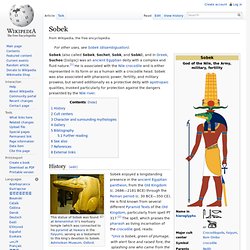
Sobek was also associated with pharaonic power, fertility, and military prowess, but served additionally as a protective deity with apotropaic qualities, invoked particularly for protection against the dangers presented by the Nile river. History[edit] Sobek enjoyed a longstanding presence in the ancient Egyptian pantheon, from the Old Kingdom (c. 2686—2181 BCE) through the Roman period (c. 30 BCE—350 CE).
Tefnut. Etymology[edit] Literally translating as "That Water",[2] the name Tefnut has been linked to the verb 'tfn' meaning 'to spit'[3] and versions of the creation myth say that Ra (or Atum) spat her out and her name was written as a mouth spitting in late texts.[4] Mythological origins[edit] There are a number of variants to the myth of the creation of Tefnut and her twin brother Shu.
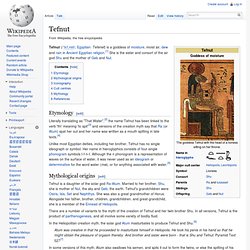
In all versions, Tefnut is the product of parthenogenesis, and all involve some variety of bodily fluid. In the Heliopolitan creation myth, the solar god Atum masturbates to produce Tefnut and Shu.[6] Atum was creative in that he proceeded to masturbate himself in Heliopolis. In some versions of this myth, Atum also swallows his semen, and spits it out to form the twins, or else the spitting of his saliva forms the act of procreation. The Coffin Texts contain references to Shu being sneezed out by Atum from his nose, and Tefnut being spat out like saliva.